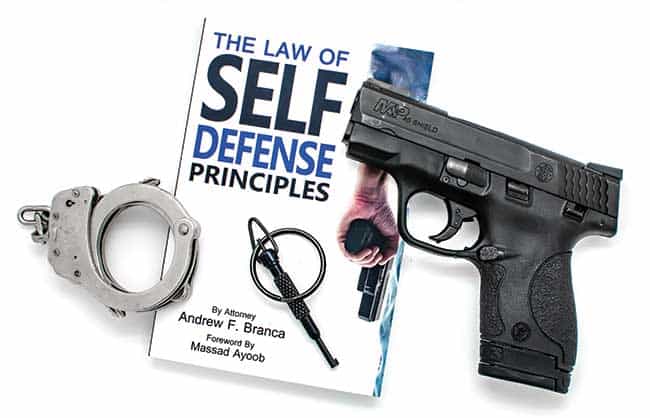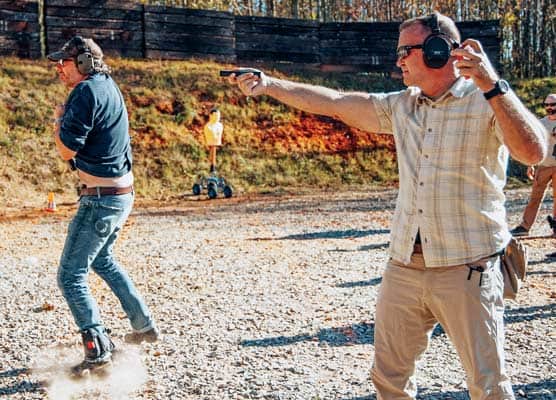Obey The Law!
Do you know enough to keep out of jail?
I am not a lawyer (and I don’t even play one on TV), so don’t take this article as legal advice. We’re all responsible for knowing the specifics of our local laws, so do your own homework! With that said, let’s explore some self-defense legal concepts to get you started on your self-defense legal journey.
Experience as a police officer and a CWP instructor has taught me most people (including attorneys) have very little knowledge concerning the laws and what can happen if they violate them. Many believe if they’re involved in a situation requiring the defensive use of their handgun the law will be on their side. They tend to believe the training received in their CWP class covers them. All you have to do is explain what happened and you’ll receive a get out of jail card, pass “Go” and collect $200. False!
I can tell you my law enforcement training and experience coupled with my instructor certification made me feel confident in my knowledge. I had responded to many critical incidents and seen firsthand what was involved. I was wrong!
It wasn’t until I read Andrew Branca’s book, The Law of Self Defense Principles, my eyes were opened to just how complicated and hazardous the laws of self-defense can be. Branca is a guest instructor and subject matter expert on self-defense law at the FBI’s National Academy at Quantico, the SIG SAUER Academy, an NRA Certified Instructor, an IDPA Charter/Life member (IDPA #13) and a Master-class competitor in multiple IDPA divisions. As a certified instructor with the Continuing Legal Education (CLE) system he teaches lawyers how to argue self-defense cases, and has published books including state law supplements for each of the 50 states. Since reading Branca’s book, I’ve completed his course on the Laws of Self Defense and the state-specific course for South Carolina.
Branca’s book covers the laws of self-defense in easy, layman’s terms, and the many examples he cites bring the laws to life. He shows what the major elements are, covers them in detail and even explains how those elements can be used against you after a self-defense shooting.
Self-Defense Concepts
Perhaps you’ve acted in self-defense (or so you believe), but you’ve been arrested and charged with murder. Do you know what this means or how you can evade the charge using the self-defense claim?
Laws of self-defense have been established through common law, statutory law and case law so we can understand some basic principles to ensure we’re on the right side of the law. According to Branca, the cumulative collection of principles can be stated in five basic elements of self-defense: innocence, imminence, proportionality, avoidance and reasonableness.
Innocence
To use self-defense as a legal principle, you must first pass the element of innocence. This means you are not at fault in precipitating the incident. To do this, you must have acted in such a way and communicated your position that you did not wish to engage in conflict. It can be in words or action, but both may provide enhanced credibility. All of this material hinges on the fact you were not committing a crime at the time. If you were, your self-defense claim goes out the window. It means the jury hearing your case will not even hear the term self-defense in your trial, and you’ll be tried under the appropriate statute. You may be the prosecutor’s ticket to a promotion.
Just as it’s possible to lose the element of innocence, it’s also possible to regain it. All of it is based on what you do and say. Knowing the element of innocence and how a prosecutor can overcome it is of vital importance to your future.
Imminence
As a police officer, this is the most emphasized element I was taught. We used the often-cited justifications of ability, opportunity and jeopardy as criteria that must be present before one is legally protected when using deadly force. The person threatening you must have the means to carry out the threat, he is within such distance or circumstances the threat becomes real and there are articulable signs he is attempting to carry out the threat now.
An example would be a suspect has indicated he will smash your head with a bat (the threat). He has a bat in his hand (the ability). He’s close enough to inflict harm to you (the opportunity). He’s taken some overt movement to effect harm, such as raising the bat to strike you (you are in imminent jeopardy at this point). If he’s 50 feet away, the situation changes. He doesn’t have the opportunity. Or if he never makes an overt move to hit you, then you are not in jeopardy. The key to imminence is the threat is present right now and there is no alternative to avoid the conflict. It’s actually more complex than I was taught in the police academy. In order to survive a legal battle, know the rules and how they can be used against you. Otherwise it could be just as deadly as the threat you defended yourself against.
Proportionality
If an acquaintance playfully uses his fist and hits you on the shoulder, it makes no sense to use deadly force. It’s substantially unreasonable. But let’s say your acquaintance has been drinking and has become belligerent before he hits you. These circumstances are different and raise the stakes. Still, it may not be reasonable to use deadly force absent extenuating and supporting evidence. A fight might injure you, but still may not reach the level of being an imminent threat of death or serious bodily harm — the guiding principle justifying deadly force. But suppose he’s twice your size, or you know he’s trained in MMA fighting. This might impact justification.
The element of proportionality is the weighing of the totality of the circumstances and of your ability to defend yourself. Police typically use a “force continuum” and are required to use the least amount of force necessary to eliminate the threat. Perhaps all that’s needed to diffuse the situation is using verbal judo or some other less-physical technique. If this doesn’t work, you may go up the force continuum to open-hand defense, closed-hand defense or chemical or impact weapons. This continuum escalates up to and includes the use of deadly force. The amount of force you use must be reasonable in the situation and circumstances. You must know what is available to you and make a judgment call on how to respond to meet the test of proportionality.
Avoidance
Were there other avenues available? Did you avail yourself of these rather than using deadly force? If you could have avoided the conflict but didn’t, you could fail this element of your defense. Granted, there are some situations or circumstances that relieve you of this responsibility. Many states have “stand your ground” statutes altering the avoidance principle. Still, there are ways around even those, and prosecutors may use them.
Reasonableness
Branca describes reasonableness as being an umbrella over the other elements. If a “reasonable and prudent” person evaluated each element in a case, would they agree each meets a standard of reasonableness? Many cases address these decisions and each state generally has its own set of statutes, case law and jury instructions regarding self-defense. It’s important you understand what these are and how they’ll be seen by a judge or jury who evaluates your actions with 20/20 hindsight.
At the end of the day, understand if you’re charged with a crime as a result of using a firearm in self-defense, much about your situation will be outside of your control. It’s scary to think about, but crucial to understand.
Educate yourself as if your life depends on it, because it just might.
For more info:

Get More Personal Defense Tips!
Sign up for the Personal Defense newsletter here:





